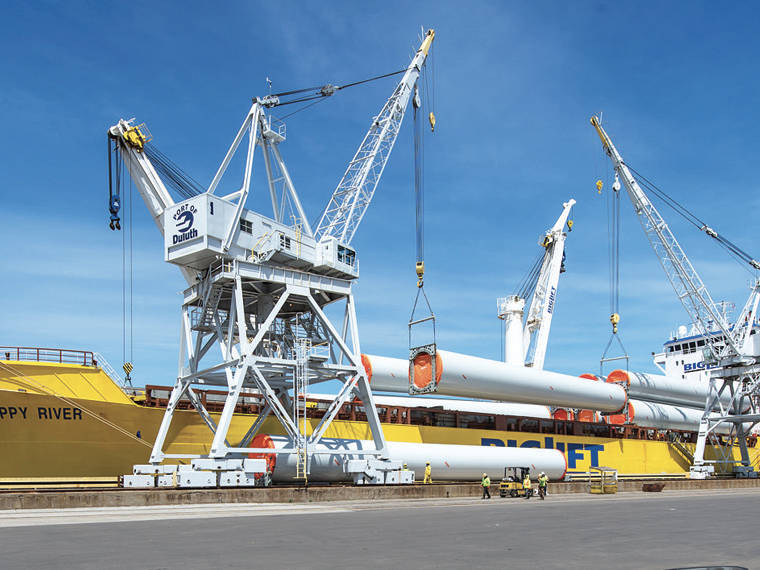Page 1: Wind Energy Powers Diversification
Page 2: Port of Indiana-Burns Harbor
Page 3: Proposed Offshore Wind Project on Lake Erie
Page 4: New Laydown Areas Benefit Canadian Ports
Project cargo’s growing diversification role
Throughout the vast Great Lakes-St. Lawrence Seaway system in the United States and Canada, most ports seek to diversify their customer base by developing new business beyond traditional bulk markets. Front and center in their efforts are project cargoes, especially wind energy components destined to meet the rising demands of utilities. On the horizon, too, is a project in Ohio that could soon become the first offshore wind facility in the Great Lakes.

Wind Energy Powers Diversification
At the Port of Duluth, the top tonnage port on the Great Lakes (32 million metric tons), the Clure Public Marine Terminal handles high-value general cargo as well as project and dimensional cargoes.
Deb DeLuca, port director of the Duluth Seaway Port Authority, recently stated that “cargo diversity is important to any port and its catchment area. A mix of cargo spells economic stability.”
The port on Lake Superior along the border of Minnesota and Wisconsin has strong expectations for 2020 after shattering a wind energy cargo record last year. In total, Duluth welcomed 306,000 tons of wind energy cargo in 2019. This eclipsed the previous summit of 302,000 tons in 2008. Duluth Cargo Connect managed the unloading, storage and dispatch of the cargo to various sites in the Midwest.
Such a banner performance was termed “no accident” by DeLuca. “We’ve made more than $25 million in strategic investments to the terminal in the past four years, enhancements that help support the excellent work Duluth Cargo Connect does in handling these oversize wind cargoes.”
Indeed, the tower sections are long, but the blades are even longer – with some well past 200 feet.
“Wind energy has been an important part of our cargo portfolio, dating back to our first shipments more than a decade ago,” noted Jonathan Lamb, president of Duluth Cargo Connect. “As the farthest inland port in North America, we’re geographically well situated to support wind farm installations in the Upper Midwest and central Canada. We pride ourselves in providing a seamless connection between modes of transportation for our wind energy customers.”
Strapped for space and needing more laydown area, the port is adding 50,000 square feet of warehouse space and rebuilding two dock walls at a cost of $21 million, with construction planned for 2021-2023. Beyond wind components, Lamb says that Clure Terminal is targeting dimensional cargoes including transformers, reactors, pressure vessels and similar equipment serving mining, manufacturing, and oil and gas industries.
A number of U.S. Great Lakes ports are developing reputations for the efficient handling of project and heavy lift cargo. The Port of Bay City, Michigan on Lake Huron handled five wind energy cargoes in 2019. And the Port of Indiana-Burns Harbor handled one of the more unique project cargoes in 2019 when it moved two huge rubber-tired gantry cranes (RTG) from the port to the CSX Intermodal Terminals’ facility in nearby Chicago. The 68-piece cargo arrived at the Indiana port in June aboard the HC Melina and was discharged from the vessel by Federal Marine Terminal’s (FMT) shore crane for transport to the CSX Intermodal Terminals’ Bedford Park facility, which handles domestic and international freight.

Follow us on social media: